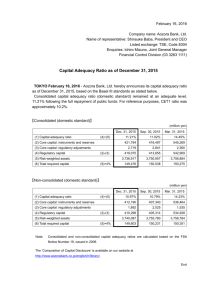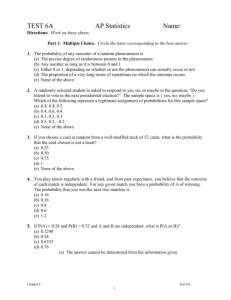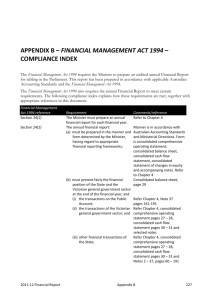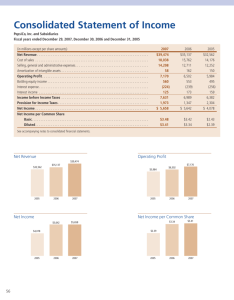Methods for estimating consolidated balance sheets for the financial
advertisement
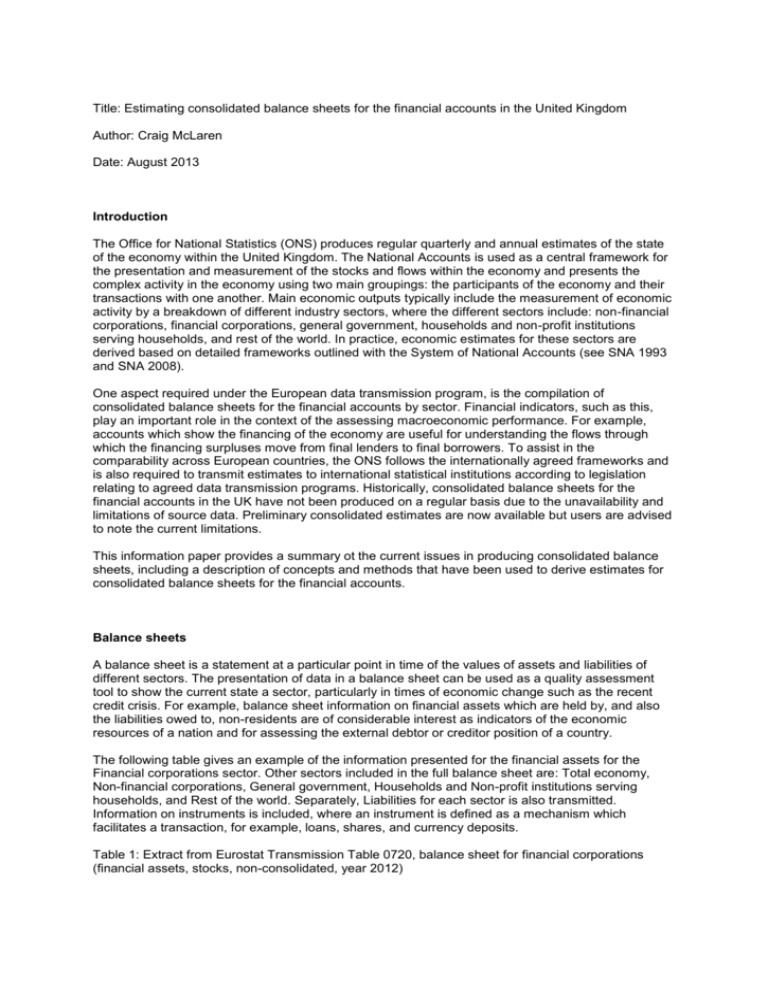
Title: Estimating consolidated balance sheets for the financial accounts in the United Kingdom Author: Craig McLaren Date: August 2013 Introduction The Office for National Statistics (ONS) produces regular quarterly and annual estimates of the state of the economy within the United Kingdom. The National Accounts is used as a central framework for the presentation and measurement of the stocks and flows within the economy and presents the complex activity in the economy using two main groupings: the participants of the economy and their transactions with one another. Main economic outputs typically include the measurement of economic activity by a breakdown of different industry sectors, where the different sectors include: non-financial corporations, financial corporations, general government, households and non-profit institutions serving households, and rest of the world. In practice, economic estimates for these sectors are derived based on detailed frameworks outlined with the System of National Accounts (see SNA 1993 and SNA 2008). One aspect required under the European data transmission program, is the compilation of consolidated balance sheets for the financial accounts by sector. Financial indicators, such as this, play an important role in the context of the assessing macroeconomic performance. For example, accounts which show the financing of the economy are useful for understanding the flows through which the financing surpluses move from final lenders to final borrowers. To assist in the comparability across European countries, the ONS follows the internationally agreed frameworks and is also required to transmit estimates to international statistical institutions according to legislation relating to agreed data transmission programs. Historically, consolidated balance sheets for the financial accounts in the UK have not been produced on a regular basis due to the unavailability and limitations of source data. Preliminary consolidated estimates are now available but users are advised to note the current limitations. This information paper provides a summary ot the current issues in producing consolidated balance sheets, including a description of concepts and methods that have been used to derive estimates for consolidated balance sheets for the financial accounts. Balance sheets A balance sheet is a statement at a particular point in time of the values of assets and liabilities of different sectors. The presentation of data in a balance sheet can be used as a quality assessment tool to show the current state a sector, particularly in times of economic change such as the recent credit crisis. For example, balance sheet information on financial assets which are held by, and also the liabilities owed to, non-residents are of considerable interest as indicators of the economic resources of a nation and for assessing the external debtor or creditor position of a country. The following table gives an example of the information presented for the financial assets for the Financial corporations sector. Other sectors included in the full balance sheet are: Total economy, Non-financial corporations, General government, Households and Non-profit institutions serving households, and Rest of the world. Separately, Liabilities for each sector is also transmitted. Information on instruments is included, where an instrument is defined as a mechanism which facilitates a transaction, for example, loans, shares, and currency deposits. Table 1: Extract from Eurostat Transmission Table 0720, balance sheet for financial corporations (financial assets, stocks, non-consolidated, year 2012) Consolidation and European requirements Within the National Accounts framework, estimates can be derived on a non-consolidated or consolidated basis. Consolidation refers to the elimination, from both uses and resources, of transactions that occur between units when units are grouped, and to the elimination of reciprocal financial assets and liabilities. Both the System of National Accounts (SNA), and the European System of Accounts (ESA) note the importance of consolidation. This international guidance defines consolidation as follows: "Consolidation in the financial account refers to the process of offsetting transactions in financial assets for a given group of institutional units against the counterpart transactions in liabilities for the same group of institutional units.Consolidation can be performed at the level of the total economy, of institutional sectors, and of sub-sectors. The financial account of the rest of the world is consolidated by definition since only transactions of the non-resident institutional units with resident institutional units are recorded. (ESA, 1.106 and 5.25; SNA 2.68 and 11.43)" In the case of balance sheets, consolidated accounts eliminate those assets of a sector that are liabilities of units in the same sector. For financial transactions, consolidated accounts remove transactions between units in the same sector. As part of the European statistical tranmission program (see ESA 95), there is a legal requirement on the delivery of statistical information related to the financial balance sheets. In this situation, the required transmissions are for non-consolidated and consolidated balance sheet estimates for transmission Table 6 (financial transactions in period T-1 to T by sector and by instrument) and transmission Table 7 (balance sheet by sector and by instrument). Consolidated estimates are given within transmissionTables 0610 and 0710. Non-consolidated estimates are given within transmissionTables 0620 and 0720. It should be noted that the net financial transactions, e.g. assets minus liabilities, remains the same before and after consolidation. There are two main approaches to deriving consolidated estimates. Some countries collect consolidated information direct from business enterprises, and then derive non-consolidated data from this information by adding other transaction information on to the consolidated estimates. Other countries collect the non-consolidated data first, and derive the consolidated data by removing the other transaction infromation. The United Kingdom currently collects non-consolidated data as a first step and derives the consolidated data. Consolidation in the United Kingdom Within the UK, non-consolidated data for the balance sheet is available by sector and by instrument (transmission Table 0720) , and also for the financial transactions in period T-1 to T by sector and by instrument (transmission Table 0620). To derive the consolidated estimates from the non-consolidated estimates, data needs to be available relating to the transactions that occur between units within each sector. These transactions would then be removed from the non-consolidated datasets. Within the UK, there is currently limited data availability meeting this requirement. The following sections describe available existing data. Share ownership Share ownership estimates are compiled every two years and uses information about the ownership of ordinary shares in quoted companies in the UK. Share ownership is measured using data from Euroclear (CREST), the electronic settlement system for equity share trading, and further analysis of share registers. Description of the methodology used is available in ONS (2012). Within the consolidated balance sheet, this means that level data is available for transaction "Quoted shares, F511" for sectors Non-financial S11, and Total financial-corporations S12. Other Financial Institution The ONS financial surveys have limited information related to Other Financial Institutions. Survey data is collected for Securities Dealers on assets and liabilities and transactions using the quarterly survey for securities dealers which retursn assetsiabilities and of Transactions in Securities. In a consolidated balance sheet context, this means that data is available for transactions "Long term loans, F42" for sector Other financial intermediaries, S123. General government Estimates for non-consolidated and consolidated data for General government (Sector 13) are available in ONS (2013). For the sub-sectors of Central government (Sector 1311) and Local government (Sector 1313), the data is already consolidated in the sense that there is no financial interaction between units within each sector. For that situation, the non-consolidated is the same as the consolidated data. However, for General government, there are some transactions across the sub-sectors and the total sector. The consolidated estimates are already published in Table 27 (ONS, 2013) and can be used in the context of this financial balance. Within the consolidated balance sheet, data is available for both flows and levels. Transactions impacted are: "Currency other deposits F29", "Short-term securities other than shares, excl financial derivatives F331", "Long-term securities other than shares, excl financial derivatives F332", "Longterm loans F42" and "Other accounts receivable (other) (lower level proxy for Other accounts receivable) F79". Monetary Financial Institutions The ONS financial surveys do not currently collect information related to Monetary Financial Institutions. Data are made available as part of collaborative agreement with the Bank of England. The data received may be on a monthly, quarterly or annual basis and are transmitted in a secure digital format. The coverage of the estimates includes monetary statistics which are collected by the Bank of England from banks (including the central bank) and building societies operating in the UK, which together make up the Monetary Financial Institutions (MFI) sector. Sectoral and industrial breakdowns of the money and credit data are available. There is also a wider measure of lending to individuals, which includes mortgage lending and consumer credit provided by institutions other than banks and building societies. Financial Statistics provided include the banks' contribution to UK GDP and balance of payments, the UK's gold and foreign currency reserves, statistics on financial derivatives and the UK's international banking activity. Also collected are effective and quoted interest rates data and statistics are compiled on new issues and redemptions of equities, bonds, commercial paper and other debt securities in the UK capital markets. In a consolidated balance sheet context, this means that data is available for sector Monetary Financial Institutions S12K for transactions "Transferable deposits, F22", "Short-term securities other than shares, excl. fin. derivatives, F331", "Long-term securities other than shares, excl. fin. derivatives, F332", "Financial derivatives, F34", “Short term loans, F41, "Long term loans, F42". Future data source requirements As part of the upcoming international regulation changes, ONS is planning to take the opportunity to implement survey development improvements related to the introduction of voluntary flow of funds data. For example, the addition of who-to-who transaction questions to be included on relevant ONS surveys. The final agreed timing and survey development will depend on allocation of ONS resources. The availability of this information, particularly for Financial institutions, will enhance the data available for the consolidated balance sheet estimates. The ONS is also planning to work closely with The Bank of England on improving the consolidated balance sheet estimates. Approach for deriving consolidated estimates Existing ONS data sources account for approximately 40% of the consolidation adjustments which are used to derive the consolidated estimates from the non-consolidated estimates. In general, ONS data is not available for consolidation at higher sector aggregates. In these cases, where who-to-who actual transactions is not currently available, an interim modelling approach has been used to ensure that the magnitude and coverage of the final consolidated estimates is appropriate within relevant sectors and instruments. This ensures that consolidation is taken account where it is known to exist. Where existing non-consolidated and consolidated data already exists, the relationship between the two datasets can be used to give an indication of the amount of consolidation that takes place for each instrument and sector. The following steps can be used: I. II. III. IV. V. Derive proportions from existing data where available, This is calculated as: (nonconsolidated - consolidated ) / non-consolidated This is done for assets and liabilities separately for each sector and instrument. To minimise the impact of division by small estimates, identify extreme cells where the proportions are greater than 1 or less than -1. Replace these with the average proportion by instrument (eg. transaction) across all sectors within a year. This is done for liabilities and assets separately. Calculate the average of the liabilities and assets proportions for the same instrument within each sector. Then to ensure identities hold, as consolidation must be equal between assets and liabilities, the proportion is set to be the same for each based on the final average. The above approach is appropriate for the estimate of consolidation for the level of stocks (Table 7) due to the general stability of the level estimates. However, for flows (Table 6), this approach can lead to issues due to the nature of the movement data which can be negative, zero and positive. An alternative modelling approach is used. I. II. III. IV. V. The general relationship can be used where: Flow at time t = Level at time t - Level at time t-1 + (Other changes and revaluation between t and t-1). This relationship holds for both non-consolidated and consolidated forms of the tables. Preserve the percentage change in levels that is attributable to other changes and revaluations. e.g. other changes and revaluation at time t = ( ( level at time t - level at time t-1) - flow at time t ) / level at time t - 1. This is calculated for the non-consolidated data. The factors for both assets and liabilities are averaged to ensure assets are equal to liabilities. Calculate the consolidated flow data at time t = ( consolidated level at time t consolidated level at time t-1) - average of other change factor * consolidated level at time t-1. Implicit in this approach is the assumption that the other changes and revaluation is the same between the non-consolidated and consolidated set of accounts at time t. As an example, the OECD.Stat website (OECD, 2013) contains datasets on countries which compile both non-consolidated and consolidated datasets. Using relevant country data from 2000 onwards, the following chart shows how the proportions relating to the amount of consolidation changes over time for the Financial Corporations sector for Financial assets in level terms for different countries. The chart shows that all countries have a similar profile for the proportions over time, apart from The Netherlands for the recent years, and the consistent level difference for Sweden. For The Netherlands estimates, this could indicate greater consolidation and money movement within the Financial Corporations sector in recent years, perhaps due to the number of special purpose entities in that country. Denmark and Sweden are similar countries to the UK in that they are within the European Union but maintain their own currency. Germany is similar to the UK in terms of the size of the financial sector. Given the movements are similar for these selected countries, and based on the size of the economy and financial sector, selected related proportions have been used to approximate the magnitude of UK consolidation for sectors where real data does not exist. In this example, the proportion based on the final UK data is reflective of the combination of actual and modeled data. Summary A first estimate for consolidated estimates for the financial balance sheet are available for download from the ONS website, link: http://www.ons.gov.uk/ons/about-ons/what-we-do/publication-scheme/published-ad-hocdata/economy/august-2013/index.html. Users should note that the current estimates are a combination of actual data and modelled estimates. Work is ongoing to enable the collection, and update, of all relevant data where possible. In future, the consolidated estimates will be released on a regular annual basis, and also take into account data updates as part of the annual Blue Book process. References European System of Accounts, 1995, See Annex A in link: http://eurlex.europa.eu/LexUriServ/LexUriServ.do?uri=CELEX:31996R2223:EN:NOT OECD, 2013, Link: http://stats.oecd.org/Index.aspx?DataSetCode=SNA_TABLE610 Office for National Statistics (2012) Ownership of UK quoted shares, 2010, Link: http://www.ons.gov.uk/ons/dcp171778_257476.pdf Office for National Statistics (2013) General government data, Link: http://www.ons.gov.uk/ons/rel/psa/maast-supplementary-data-tables/january-2013/index.html System of National Accounts, 2008, Link: http://unstats.un.org/unsd/nationalaccount/sna2008.asp System of National Accounts, 1993, Link: http://unstats.un.org/unsd/nationalaccount/sna1993.asp

